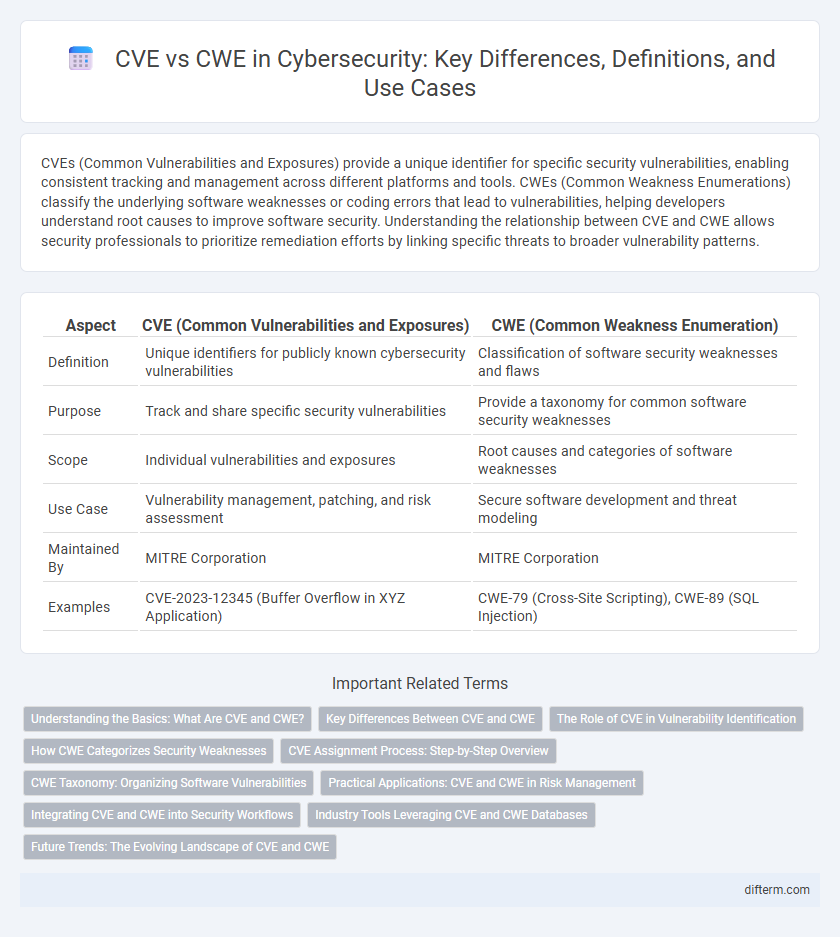CVEs (Common Vulnerabilities and Exposures) provide a unique identifier for specific security vulnerabilities, enabling consistent tracking and management across different platforms and tools. CWEs (Common Weakness Enumerations) classify the underlying software weaknesses or coding errors that lead to vulnerabilities, helping developers understand root causes to improve software security. Understanding the relationship between CVE and CWE allows security professionals to prioritize remediation efforts by linking specific threats to broader vulnerability patterns.
Table of Comparison
| Aspect | CVE (Common Vulnerabilities and Exposures) | CWE (Common Weakness Enumeration) |
|---|---|---|
| Definition | Unique identifiers for publicly known cybersecurity vulnerabilities | Classification of software security weaknesses and flaws |
| Purpose | Track and share specific security vulnerabilities | Provide a taxonomy for common software security weaknesses |
| Scope | Individual vulnerabilities and exposures | Root causes and categories of software weaknesses |
| Use Case | Vulnerability management, patching, and risk assessment | Secure software development and threat modeling |
| Maintained By | MITRE Corporation | MITRE Corporation |
| Examples | CVE-2023-12345 (Buffer Overflow in XYZ Application) | CWE-79 (Cross-Site Scripting), CWE-89 (SQL Injection) |
Understanding the Basics: What Are CVE and CWE?
CVE (Common Vulnerabilities and Exposures) identifies and catalogs publicly disclosed cybersecurity vulnerabilities, providing unique identifiers that facilitate tracking and addressing specific security issues. CWE (Common Weakness Enumeration) categorizes software weaknesses that can lead to vulnerabilities, offering a systematic way to understand root causes and potential risk patterns in code. Together, CVE and CWE help security professionals detect, analyze, and prioritize mitigation strategies for both known threats and underlying vulnerabilities.
Key Differences Between CVE and CWE
CVE (Common Vulnerabilities and Exposures) identifies and catalogs specific security vulnerabilities with unique identifiers, facilitating tracking and patching of known software flaws. CWE (Common Weakness Enumeration) classifies and describes underlying software weaknesses and coding errors that can lead to vulnerabilities, providing a framework for understanding root causes and improving secure development. The key difference lies in CVE addressing individual vulnerability instances, while CWE focuses on the general types of security flaws that cause these vulnerabilities.
The Role of CVE in Vulnerability Identification
CVE (Common Vulnerabilities and Exposures) plays a critical role in vulnerability identification by providing a standardized, unique identifier for publicly known cybersecurity vulnerabilities, facilitating consistent tracking and management. This system enables organizations, security researchers, and tools to reference vulnerabilities unambiguously, improving communication and patch prioritization. Unlike CWE (Common Weakness Enumeration), which categorizes types of software weaknesses, CVE focuses on specific instances of vulnerabilities, making it essential for effective incident response and vulnerability management.
How CWE Categorizes Security Weaknesses
CWE (Common Weakness Enumeration) categorizes security weaknesses by providing a structured classification of software vulnerabilities based on error patterns, design flaws, and implementation mistakes. Unlike CVE (Common Vulnerabilities and Exposures), which identifies specific instances of vulnerabilities in products, CWE serves as a comprehensive taxonomy that helps developers and security professionals understand the root causes and systemic issues behind vulnerabilities. This categorization facilitates more effective vulnerability mitigation strategies and secure software development by addressing the underlying weaknesses rather than isolated exposures.
CVE Assignment Process: Step-by-Step Overview
The CVE assignment process begins with the identification of a security vulnerability which is then reported to a CVE Numbering Authority (CNA). The CNA reviews the vulnerability details, verifies its validity, and assigns a unique CVE identifier following standardized criteria. This identifier is published in the CVE List, facilitating consistent tracking and communication across cybersecurity tools and organizations.
CWE Taxonomy: Organizing Software Vulnerabilities
CWE (Common Weakness Enumeration) taxonomy provides a structured framework to categorize software vulnerabilities based on their root causes and characteristics, enabling developers and security professionals to prioritize mitigation efforts effectively. Unlike CVE (Common Vulnerabilities and Exposures), which identifies specific instances of vulnerabilities in software products, CWE classifies underlying software weaknesses that can lead to such exposures. The CWE taxonomy enhances vulnerability management by organizing software flaws into hierarchical categories, promoting a deeper understanding of systemic issues across various platforms and improving secure coding practices.
Practical Applications: CVE and CWE in Risk Management
CVE (Common Vulnerabilities and Exposures) provides a standardized identifier for known security vulnerabilities, enabling organizations to quickly recognize and prioritize threats in their risk management processes. CWE (Common Weakness Enumeration) categorizes software weaknesses, helping security teams identify root causes and implement more effective remediation strategies. Integrating CVE data with CWE insights enhances vulnerability assessments and supports proactive risk mitigation by linking specific flaws to exploitable vulnerabilities.
Integrating CVE and CWE into Security Workflows
CVE (Common Vulnerabilities and Exposures) provides unique identifiers for publicly known cybersecurity vulnerabilities, enabling precise vulnerability tracking and management. CWE (Common Weakness Enumeration) categorizes the underlying software weaknesses that create security risks, facilitating root cause analysis and proactive mitigation strategies. Integrating CVE and CWE into security workflows streamlines vulnerability assessment, enhances threat prioritization, and supports strategic patch management by correlating specific vulnerabilities with their associated weaknesses.
Industry Tools Leveraging CVE and CWE Databases
Industry tools leverage CVE (Common Vulnerabilities and Exposures) databases to identify, track, and remediate known security vulnerabilities with precise, up-to-date identifiers and descriptions. CWE (Common Weakness Enumeration) databases are used to classify and analyze software weaknesses, guiding developers and security professionals in understanding root causes and mitigating potential exploitation. Integration of CVE and CWE data into vulnerability management platforms, static analysis tools, and threat intelligence systems enhances automated detection, prioritization, and response strategies in cybersecurity workflows.
Future Trends: The Evolving Landscape of CVE and CWE
CVE (Common Vulnerabilities and Exposures) continues to expand its database with more granular vulnerability identifiers, enhancing the precision of threat detection and management. CWE (Common Weakness Enumeration) evolves by integrating artificial intelligence and machine learning techniques to classify and predict software weaknesses proactively. Future trends indicate increased collaboration between CVE and CWE frameworks to provide comprehensive vulnerability intelligence, enabling more effective cyber risk mitigation strategies.
CVE vs CWE Infographic

 difterm.com
difterm.com